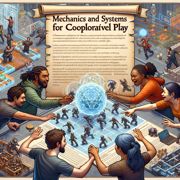Harmonious Games Cooperative Design Manifesto
Harmonious Games builds cooperative experiences around a single premise: players succeed together when systems value empathy, clarity, and meaningful interdependence. The design approach balances player autonomy with structured opportunities for collaboration, producing engagements that scale from short 2‑player encounters to persistent teams of eight or more. Below are the actionable principles and systems that guide cooperative modes, with concrete mechanics, communication frameworks, reward models, matchmaking strategies, onboarding practices, accessibility adjustments, community tools, and measurement methods.
Mechanics and Systems for Collaborative Play

Core principles require that every mechanic either enhances shared decision making or reduces friction between players. Empathy and inclusivity are achieved by designing interactions that leave room for different playstyles while preventing single points of failure. Challenge should feel distributed: success must be clearly attributable to teamwork rather than a single expert. Mechanics fall into categories that deliberately nudge players toward mutual support, complementary roles, and shared problem solving.
Fundamental mechanics include shared objectives, asymmetric roles with complementary abilities, pooled resources, and hybrid synchronous/asynchronous tasks. The following examples illustrate specific designs, operational constraints, recommended player counts, and accessibility considerations:
| Mechanic | Purpose | Typical players | Communication requirement | Reward alignment | Accessibility features |
|---|---|---|---|---|---|
| Shared objective nodes | Keeps attention centered on joint goals and prevents mission drift | 2–4 | Low visual, optional voice | Single progression track; split milestones | Visual high-contrast markers; HUD scaling |
| Complementary roles | Encourages interdependence through unique abilities | 3–6 | Medium tactical coordination | Role-specific unlocks plus shared XP | Remappable controls; role swap option |
| Pooled resources | Promotes deliberate resource diplomacy | 2–8 | Low-to-medium | Group unlocks and team upgrades | Auto-share thresholds; assist routing |
| Asymmetric abilities | Layered gameplay where players cover each other | 2–5 | High in tight encounters | Shared loot plus role prestige | Ability cooldown assists; simplified inputs |
| Synchronous raids | Real-time coordination under time pressure | 4–8 | High voice and visual | Event-based group rewards | Shorter encounter variants; spectator help |
| Asynchronous tasks | Allows persistence across different schedules | Any | Low | Contribution-based progression | Progress snapshots; opt-in help |
| Cross-platform persistence | Keeps teams intact across devices | Any | Variable | Cross-save and team vaults | UI scaling; input hints per platform |
Design details must account for latency tolerance, predictability of role outcomes, and graceful degradation when a teammate disconnects. Resource sharing systems should include thresholds that automatically protect vulnerable players and prevent griefing. Complementary roles must remain meaningful without forcing playstyles; swapping and temporary role lending are effective mitigations.
Communication, Rewards, Matchmaking, Onboarding, Accessibility
Communication systems prioritize redundancy and low cognitive load. Implement a trio of channels: visual pings and contextual icons, structured quick callouts that map to common tactical needs, and optional full voice/text for deeper coordination. Quick callouts should be programmable and discoverable through the interface. Cross-platform integration must support platform voice, WebRTC fallback, and text that persists for asynchronous catches. Tactical overlays that show intent and cooldowns reduce chatter and keep attention on gameplay rather than mic etiquette.
Rewards must reinforce cooperation instead of competition within the team. Shared progression systems such as group vaults, team-level unlocks, and achievements tied to collaborative milestones create durable social bonds. Social currency that recognizes acts of assistance, revival counts, healing delivered, and objective leadership encourages positive behaviors. Reward pacing should avoid single-player power spikes that eclipse teammates.
Matchmaking should combine skill-based and preference signals. A robust algorithm factors playstyle tags, role proficiency, latency, historical cooperation score, and friend connections. Persistent teams are supported by friend lobbies, clan systems, and the ability to save team compositions for recurring events. Skill-based matchmaking must not isolate newcomers; soft placement windows and mentor pairing can accelerate retention.
Onboarding focuses on practice that scales from safe spaces to real encounters. Interactive cooperative drills, recorded demonstrations from high-performing teams, and sandbox areas where mechanics can be practiced without penalty teach both mechanical roles and social norms. Tutorial modules should simulate common failure modes and model desirable etiquette, such as callout conventions and respectful conflict resolution. Accessibility options include remappable controls, simplified input modes, assistive aim, AI-driven role supports, and role-based difficulty adjustments that let experienced players take on tougher tasks while novices contribute meaningfully.
Community, Moderation, Data, and Showcases

Community building centers on scheduled cooperative events, recurring campaigns that require sustained teamwork, and tournaments with tiers for mixed-skill participation. Moderation tools must scale with community size. Effective tools include lightweight in-game reporting, automated pattern detection for toxic behavior, swift temporary measures for repeat offenders, and transparent appeal pathways. A code of conduct and visible enforcement increase trust.
Data collection should focus on cooperation metrics that correlate with long-term retention and positive sentiment. Key indicators include average party size, frequency of revives per hour, successful objective completions per session, use of callouts, mean time to reconnect, and rate of voluntary role swaps. Regular playtesting cycles leverage telemetry and controlled experiments. A/B experiments can test variants such as differing reward splits, UI callout prominence, or matchmaking weightings. Use observed behavior to iterate on mechanics rather than relying solely on survey responses.
Showcases of successful cooperative modes highlight both mechanical and social design. Case narratives should emphasize measurable outcomes: retention lifts after introducing shared progression systems, reductions in toxic reports following voice moderation tools, and improved win rates with redesigned role clarity. Player stories and community case studies that describe specific events, dates, and outcomes make the impact tangible and provide models for replication.
Harmonious Games’ approach centers on systems that scaffold empathy, reduce friction, and celebrate collective achievement. When mechanics, communication, rewards, onboarding, accessibility, moderation, and data practices are aligned, cooperative experiences become spaces where diverse players collaborate reliably and joyfully. Continuous measurement, community feedback, and careful iteration ensure those experiences evolve to meet real player needs.